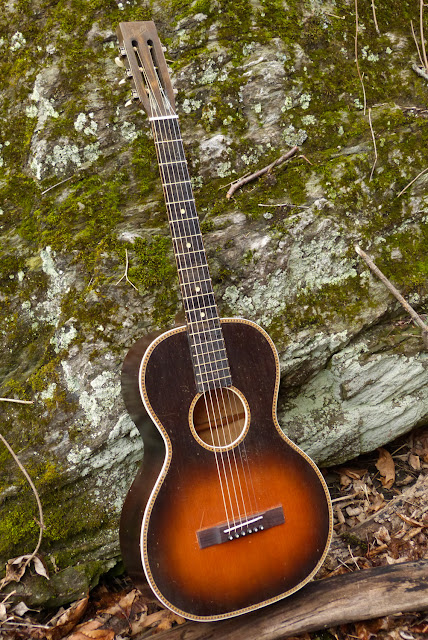1920s Oscar Schmidt "Stella" Spruce/Birch Parlor Guitar
I've worked on two or three of this same model before, and like most mid-grade Oscar Schmidt-made "parlor" guitars, it has an excellent, warm, woody, bluesy tone that suits both an ardent fingerpicker and an old-timey, country-picking flatpicker. They're great, flexible-use guitars and definitely have that old 12-fret vibe to a "t." They're also pretty loud for their size and that projection and warmth is what makes them ideal as little bluesers. They can also be "thumped-on" without getting a woofy tone to them.
A consignor brought this in and I'd done a neck reset and replacement bridge job last week, but finished it up today with a fret level/dress (and seating), new bone saddle and nut, and setup. I may have glued a couple braces, too. It has, remarkably, no cracks that I can find. The top is also spruce which is rarer for a Schmidt (the vast majority are birch) and gives it a bit less honk and more wood, tone-wise. The neck is poplar and the fretboard is stained maple, while the replacement bridge is rosewood.
It's playing perfectly with 1/16" DGBE and 3/32" EA action at the 12th fret, strung with 12s. The neck is straight and while the original frets are low and brass, they've got life left in them. I added side dots for ease-of-use, too. It has a 1 7/8" nut width and a bigger C/V hybrid neck shape and 25" scale length. The body is 13 1/4" on the lower bout and 3 3/4" deep.
Aside from average usewear, the guitar is pretty clean for its type and age. The sunburst looks grand and while the black/brown at the edges isn't intense (it's a little faded), it really does pop.
The stained-maple fretboards always end-up looking savaged by the time they reach us these days.
The top and soundhole are bound in white celluloid. Also -- don't you love the weird wooden purfling?
The original bridge was black-painted birch (and non-compensated) that had started to split on one wing and so I replaced it with a same-size rosewood one cut "in the Gibson fashion" with the pins a little farther aft. The new, compensated saddle is bone and the pins are 1920s, pearl-inlaid ones from my parts-bin. This came with 5 of the original pins (in a similar style), but I didn't have a vintage match and so I swapped these in, instead. They're very close.
The new saddle is drop-in and so action adjustments are made easily.
The back and sides are birch and the backstrip is just a decal.
The original tuners got a lube and they're good to go.
The endpin is new and ebony.
During the reset I both glued and bolted it. The joint was a little funky from an old shim job and so it's simply extra security. I re-shimmed the joint when I glued it and it was tight without the bolts.






















Comments